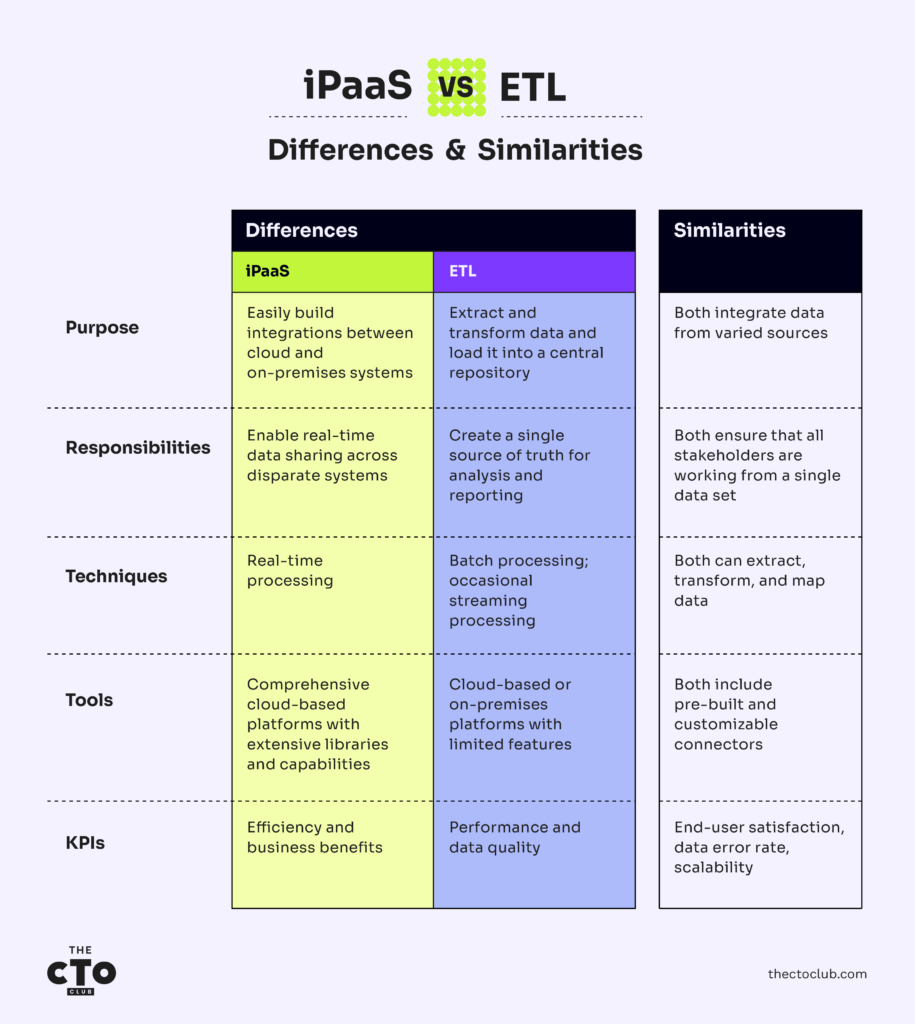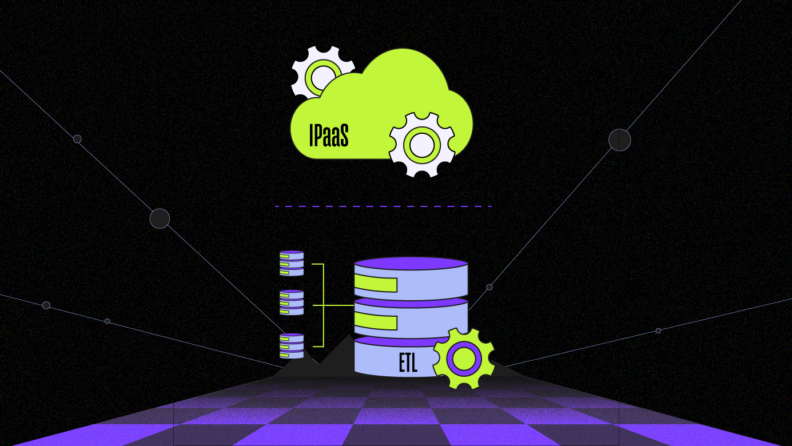If your organization is among the 89% of global businesses undergoing a digital transformation, you need a way to integrate data from various sources. That brings up a choice: iPaaS vs. ETL. While both solutions integrate data, they approach it differently.
iPaaS enables real-time data integration across all cloud and on-premises systems, while ETL tools extract and transform data before loading it into a data warehouse. The right solution for your company depends on your unique business needs.
Seamless integration is crucial, and data integration tools will help you get there. This article compares two powerful solutions for conquering data integration challenges. I'll explore their unique strengths, how they differ in real-time vs. batch processing, and ultimately, which champion is right for your business needs.
What is iPaaS?
Integration platform as a service (iPaaS) is a cloud-based solution that enables you to quickly build integrations and functionality between all your company's systems, whether they're deployed in the cloud or on-premises. That way, you can share data and create automated workflows across SaaS applications, legacy systems, business processes, devices, cloud services, and data sources, just to name a few.
Note that though it looks similar, iPaaS is not the same as PaaS (platform as a service). The iPaaS vs. PaaS discussion is very different from that of iPaaS vs. ETL.
What is ETL?
Traditional ETL (extract, transform, load) is the process of extracting data from a variety of sources, transforming it into a standardized format, and loading it into a central repository — usually, a data warehouse or a data lake. You can use this unified data for a range of applications, including data analysis, reporting, machine learning, and decision-making.
iPaaS vs. ETL: Differences & Similarities
ETL and iPaaS are both designed to handle data integration and data migration in a complicated business ecosystem. Before you choose, it's also important to consider the differences — they impact everything from pricing to scope and implementation.
Here's a summary of how iPaaS and ETL are different and similar in a few core areas:

Differences
Many of the key differences between iPaaS and ETL involve the capabilities, flexibility, and scalability of the system.
1. iPaaS aims to build integrations between systems, while ETL creates a central data repository
The purpose of an iPaaS solution is to integrate all of your company's applications, devices, and systems. It's an effective way to consolidate data from new cloud services, older legacy systems, data warehouses, and everything in between. You can also use integrations to set up workflow automation that streamlines business processes.
ETL extracts raw data from a range of sources and identifies differences between the source and the destination. Then, it transforms the data into a standard format and loads it into a central repository. This process ensures that your company's data is complete, accurate, and consistent.
2. iPaaS allows real-time data sharing, while ETL creates a single source of truth
When you use an iPaaS platform, data flows constantly between disparate systems and applications. If a production employee uploads capability projections, the information is immediately available to sales and marketing teams. By enabling apps and employees to access current data in real time, iPaaS increases efficiency, productivity, and innovation.
ETL, on the other hand, helps you transform your company's data into a single source of truth. Instead of sharing information between different applications, it's loaded into a data warehouse for easier access. The C-suite can connect business intelligence tools to run analytics, and the HR director can run reports on KPIs that track employee performance.
3. iPaaS processes data on the fly, while ETL uses batch processing
One of the key differences between iPaaS and ETL tools is the way they process data. Most iPaaS platforms use real-time processing. The information is mapped and transformed as it comes in, making it available to all integrated systems. That means that after a salesperson enters a new client into the CRM, they can open the quoting system and access the same data — no copying or manual entry required.
Traditionally, ETL systems have used batch processing. They gather data over a period of time and run it through the ETL stages in batches. This strategy conserves computing resources, maximizes efficiency, and improves accuracy.
As these systems develop, processing differences are becoming blurred. Most iPaaS systems can also handle batch processing, and many ETL tools now offer streaming ETL.
4. iPaaS uses comprehensive cloud-based platforms, while ETL uses more limited cloud-based or on-premises platforms
ETL has been around in some form or another since the 1970s. Originally, ETL tools were on-premises; today, they're more likely to be cloud-based. The technology has a much narrower scope than iPaaS — it's usually designed solely for ETL tasks. The best ETL tools range from high-code to no-code and often come with a limited selection of connectors and data transformations.
iPaaS tools, which are newer and primarily cloud-based, are much more comprehensive, flexible, and scalable. In addition to ETL tasks, they can handle application integration, API management, data analysis, workflow automation, and process optimization. Most come with an extensive ecosystem of connectors and templates that help you integrate new data sources quickly.
5. iPaaS KPIs tend to focus on efficiency and business benefits, while ETL KPIs involve performance and data quality
Because ETL processes are mostly concerned with large-scale data movement, relevant KPIs usually measure the performance of the system and the quality of the transformed data. You might track metrics such as:
- Average processing time
- Average batch volume
- Data throughput for ETL pipelines
- Data latency
- Data compliance
iPaaS solutions require more complex metrics. They can vary considerably based on the process you're measuring. Wondering if your integrations and workflow automations are improving overall operational efficiency? Monitor the average time to market, average time spent on tasks, and the number of workflow automations.
Other iPaaS KPIs to consider include:
- Increase in trading partner connections
- Change in order volume
- Cost per acquisition
- Utilization of iPaaS endpoints
- Average customer satisfaction ratings
Similarities
As data sources become more varied and complex, iPaaS and ETL tools have evolved in the same direction. Modern solutions share many similarities.
1. Both integrate data from varied sources
Any digital transformation journey requires you to manage data integration across multiple data sources. Depending on your operations, this integration process could include emails, websites, SQL servers, flat files, XML files, CRM systems such as Salesforce, SaaS applications, and API tools. Both ETL and iPaaS can accommodate these on-premises and cloud sources. You can use them to integrate data from your company's legacy IBM mainframe, old Excel files, and Freshdesk customer support apps.
2. Both ensure that stakeholders are working from the same data
ETL and iPaaS both aim to unify all your company's data. They eliminate silos and overcome differences in the source data to ensure employees are making decisions based on the same information. As a result, it's possible to avoid some of the bottlenecks, delays, and overlapping that happen when your sales, advertising, and marketing teams are each maintaining separate customer data sets.
3. Both extract, transform, and map data
iPaaS systems offer the same core capabilities of an ETL tool: extracting, transforming, and mapping data. Both tools take raw data and convert it into a format that's accessible and useful for your employees and connected systems.
4. Both include pre-built and customizable connectors
Many iPaaS solutions and ETL tools offer low-code and no-code solutions that are accessible for technical and business users. Employees can choose from a variety of pre-built connectors, templates, and models to suit their integration needs — or create their own using a drag-and-drop interface. Your developers and data engineers may also be able to hard-code connections for complex integrations or mapping scenarios.
5. Both use KPIs for data error rates, user satisfaction, and scalability
Both ETL and iPaaS systems rely heavily on data. To make sure the systems are handling and transforming data accurately, it's important to monitor the error rate.
Whether you're using iPaaS or ETL, scalability is an important concern. These KPIs can help you see if the process runs smoothly with each expansion:
- Processing speed
- Scaling costs
- Revenue growth
A good ETL or iPaaS should benefit the end user. How can you tell? Track employee and customer satisfaction. You can even monitor the employee turnover rate to see if there's a noticeable change in retention after implementation.
Is iPaaS or ETL Better?
For most companies, iPaaS is likely the better solution. After all, it has all the features of an ETL tool — but that's just the start. iPaaS can integrate your data and your systems, creating an interconnected and flexible ecosystem that scales easily to accommodate new technologies, data sources, and opportunities. That's critical, especially as cloud-based apps become more powerful and widely available.
Most iPaaS tools come with additional features that make your company more efficient and productive. They also tend to be more user-friendly than ETL tools, which increases accessibility and helps you build a data-focused culture. If you want a solution that falls somewhere between ETL and iPaaS, you can also consider ETL vs. ELT.
Takeaways
Whether you use ETL or iPaaS to manage data integration, it's important to keep up with new developments. We're here to help. Subscribe to our newsletter, and we'll send the latest updates right to your inbox.




